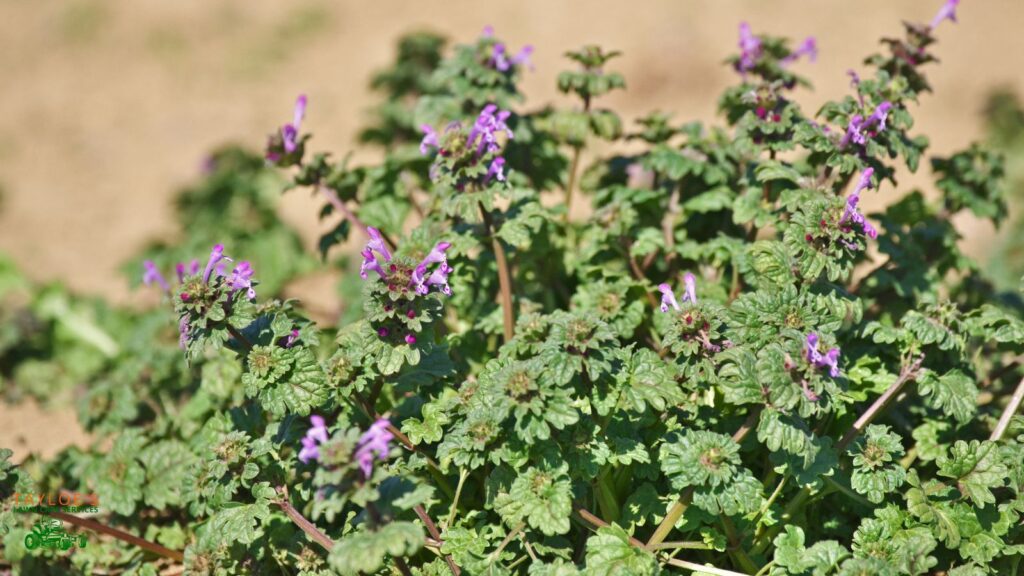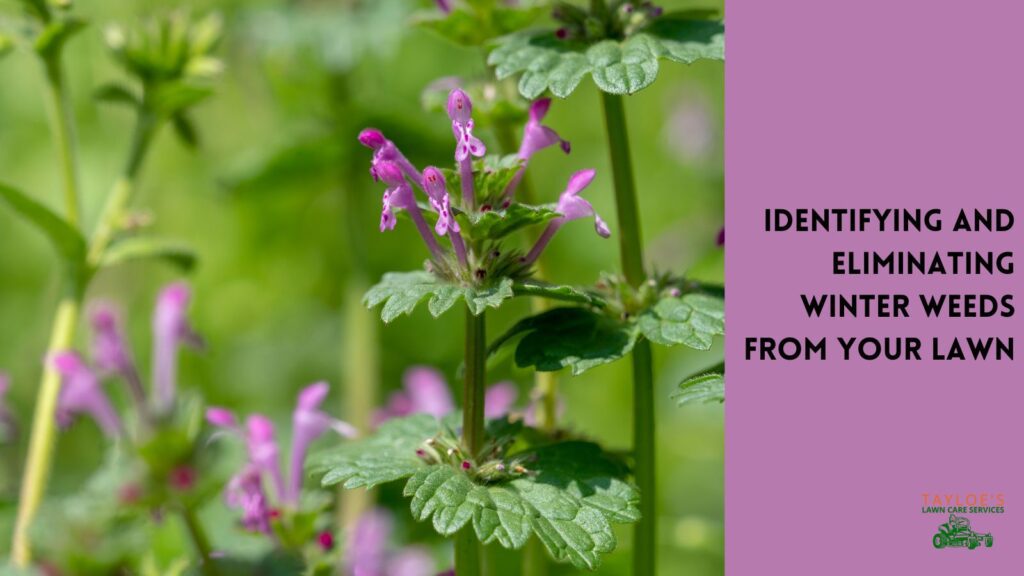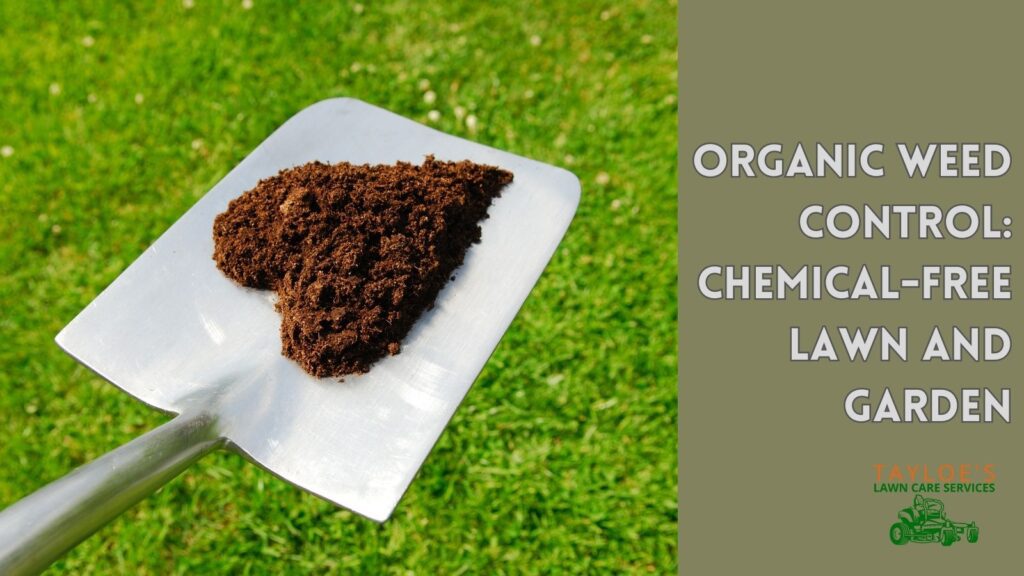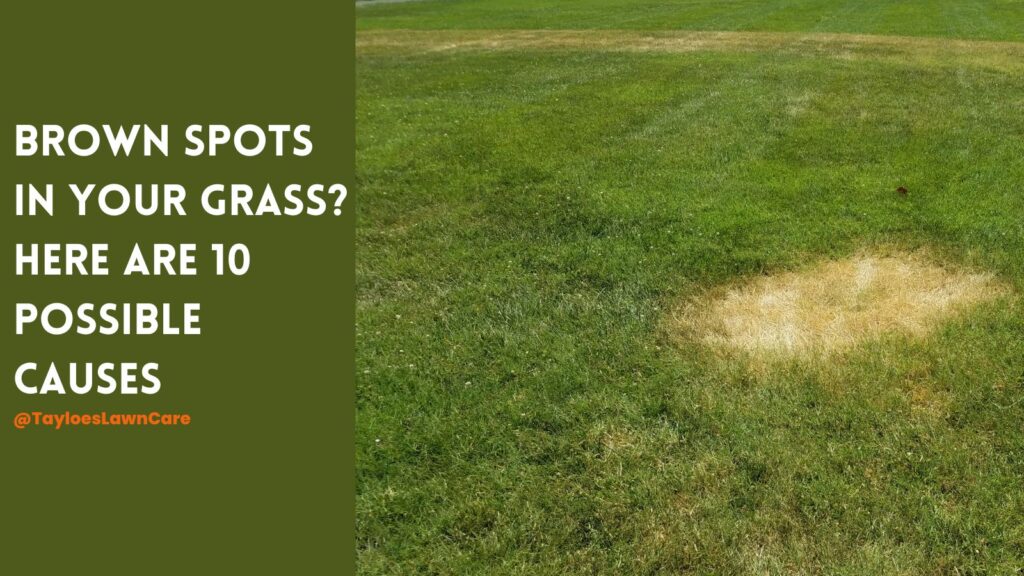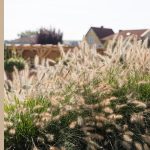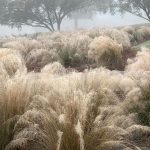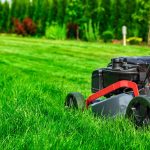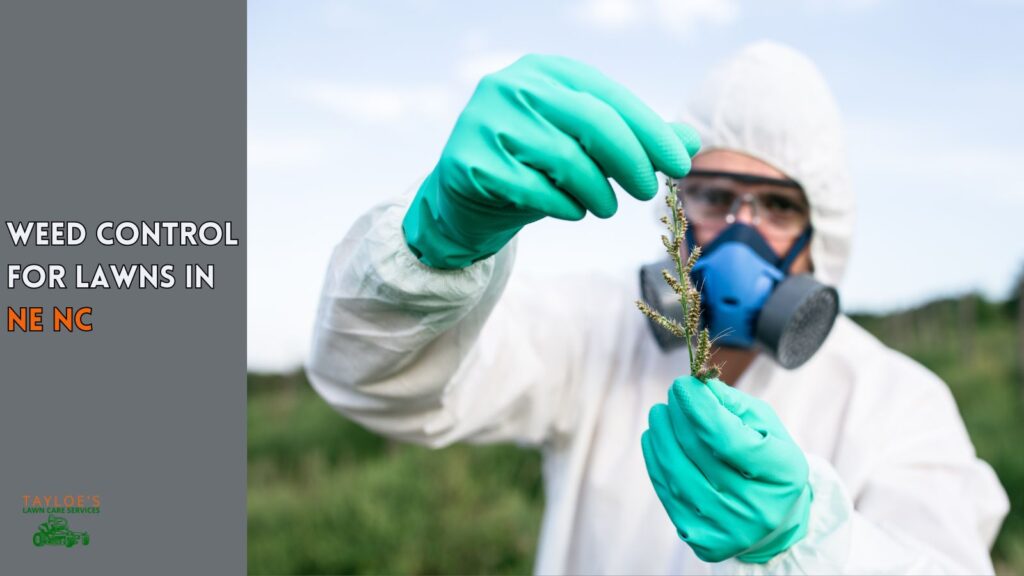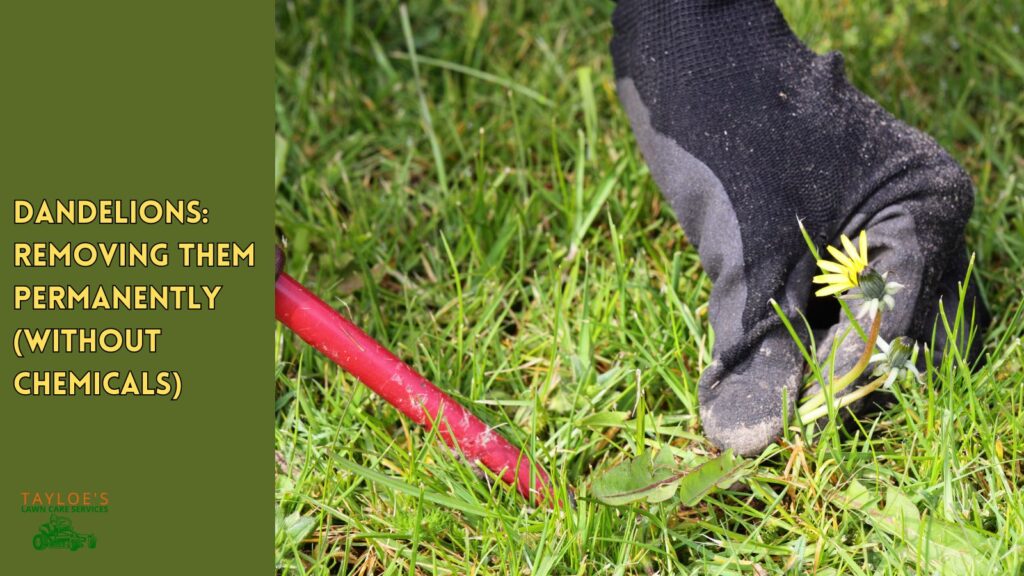Last Updated on: 9th May 2024, 11:15 am
Here’s why you shouldn’t let henbit grow out of control.
Henbit (Lamium amplexicaule) is a common winter weed in lawns and gardens, particularly in temperate regions. It’s a member of the Lamiaceae family, which includes many other well-known plants like mint and basil. Henbit is a winter annual, meaning it germinates in the fall, survives through the winter, and completes its life cycle by the end of spring.
About Henbit
Appearance and Characteristics: Henbit is easily identifiable by its unique features. It has a square stem, typical of the mint family, and grows to about 10 to 30 cm (4 to 12 inches). The leaves are rounded or heart-shaped, with a crinkled appearance and a distinctive reddish-purple color. Henbits produce small, tubular flowers in the late winter to the earliest days of spring. They’re pink or purple, adding a splash of color to lawns and signaling their invasive nature.
Growth and Spread: Henbit prefers moist, fertile soils and can thrive in light conditions, from full sun to partial shade. It spreads primarily by seeds, easily dispersed by wind, water, or human and animal activity. A single plant can produce many seeds, rapidly colonizing new areas. This weed’s ability to grow under various conditions makes it a persistent challenge in lawns and gardens.
Impact on Lawns and Gardens: While Lamium amplexicaule is not harmful to humans or pets, it competes with grass and other desirable plants for nutrients, water, and light. Its dense growth can suffocate smaller plants and create an uneven appearance in lawns. Furthermore, henbit can serve as a host for various pests and diseases, potentially affecting the overall health of your garden.
Understanding these aspects of henbit is crucial for effective management and prevention. By recognizing its growth patterns and environmental preferences, homeowners and gardeners can take proactive steps to control this weed and maintain the health and appearance of their outdoor spaces.
Why Control Henbit?
Managing Lamium amplexicaule in lawns and gardens is more than just a cosmetic concern; it’s a necessary step for maintaining the health and vitality of your outdoor spaces. Henbit, with its rapid growth and prolific seeding, poses several challenges:
- Competition for Resources: Henbit competes aggressively with grass and other desirable plants for essential nutrients, water, and sunlight. This competition can weaken your lawn, making it susceptible to disease and other weed invasions.
- Aesthetic Impact: While attractive to some, Henbit’s sprawling growth and distinctive purple flowers can disrupt the uniform green appearance of a well-maintained lawn. For those seeking a manicured landscape, controlling henbit is essential to achieving and maintaining this aesthetic.
- Pest and Disease Host: Henbit can host various pests and diseases, as they can then spread to other plants in your garden. Managing Lamium amplexicaule helps reduce these risks and maintains the general health of your lawn and garden.
- Habitat for Insects: Some insects found on henbit, like the first-of-spring bees, are beneficial. Still, others may harm your garden. Henbit can provide a breeding ground for these insects, leading to potential infestations.
- Allergenic Pollen: Although not as allergenic as some other weeds, henbit can contribute to pollen production in your garden, which may affect individuals with certain allergies.
Understanding the reasons for controlling henbit underscores the importance of an integrated approach to lawn care. By managing this weed effectively, you not only enhance the visual appeal of your lawn but also contribute to its overall health and the well-being of the surrounding ecosystem.
Henbit Identification Tips
Correctly identifying Lamium amplexicaule is the first step in effective weed control. Henbit can be confused with similar-looking weeds, but there are specific characteristics that distinguish it:
- Leaves: Henbit leaves are unique in their shape and arrangement. They are round or heart-shaped with deeply scalloped edges and grow directly around the stem in a whorled pattern. The leaves are often green with a hint of purple, especially in the cooler months.
- Stems: The stems are square-shaped, a common trait in the mint family, to which henbit belongs. These stems are often green but can have purplish hues.
- Flowers: Henbit flowers are small, tubular, and pink to purple. They typically bloom in early spring and are clustered at the top of the stems. The flowers are a key identifying feature, as they are quite distinctive in shape and color compared to other common lawn weeds.
- Growth Pattern: Henbit grows low to the ground and can form dense mats. It typically germinates in the fall and experiences a growth surge in the spring in cooler growing zones. However, henbits do not remain dormant in winter in moderate or warmer climates, particularly here in northeastern North Carolina. Instead, it thrives and grows during these cooler months, making year-round vigilance essential in these regions.
- Habitat: This weed is commonly found in disturbed soils, gardens, lawns, and along roadsides. It prefers moist, fertile soils but can adapt to various conditions.
- Seasonal Behavior: Henbit appears in the cooler autumn or winter months, with flowering and peak growth occurring in the early spring. This seasonal behavior is important for effective timing control measures.
By familiarizing yourself with these identification tips, you can confidently distinguish henbit from other weeds. Early identification allows for more effective and targeted control measures, ensuring better health and appearance of your lawn.
Organic Control Methods for Henbit
Organic methods for controlling henbit are environmentally friendly and can be highly effective. These strategies focus on prevention, direct removal, and natural treatments:
Soil Health and Preventive Measures
- Healthy Lawn Practices: Maintaining a healthy, dense lawn is the first line of defense. Regular mowing, proper watering, and appropriate fertilization create an environment less conducive to henbit growth.
- Overseeding: Introducing competitive grass species can help crowd out henbit. Choose grass varieties well-suited to your USDA growing zone. Our clients are in either zone 7b or 8a.
- Mulching: Applying a 2″ thick layer of organic mulch in garden beds can prevent henbit seeds from germinating by blocking sunlight.
Natural Herbicides and Remedies
- Vinegar-Based Solutions: A mixture of vinegar, water, and a small amount of dish soap can be an effective natural herbicide. Spray directly on the henbit, ensuring contact with the leaves.
- Boiling Water: Pouring boiling water directly onto Lamium amplexicaule can kill the plant. This method is suitable for small infestations or areas where other plants are not at risk.
- Corn Gluten Meal: This natural pre-emergent herbicide can inhibit seed germination. Apply in early spring before henbit seeds start to sprout.
Manual Removal
Implementing these organic control methods requires persistence and patience. However, they offer a sustainable approach to managing henbit, minimizing environmental harm and beneficial organisms in your lawn.
Manual Removal Techniques
Manual removal techniques offer a straightforward and chemical-free method to manage henbit for those preferring a hands-on approach to weed control. Here are some effective strategies:
Hand-Pulling
- Timing: The best time for hand-pulling henbit is when the soil is moist after rain or irrigation. Moist soil allows for easier extraction of the roots.
- Technique: Grasp the henbit close to the base and pull gently to avoid breaking the stem. Just be sure that the whole root system is removed to prevent regrowth.
- Regular Inspection: Regularly inspect your lawn for henbit, especially during its active growth periods. Early detection and removal can prevent the weed from establishing and spreading.
Removing using a hoe
- Hoe Selection: Use a sharp hoe or cultivator to slice through the soil and cut the henbit stems at or below the soil surface.
- Method: Slide the hoe beneath the soil surface near the base of the henbit plants. The goal is to sever the roots from the stems, hindering the plant’s regrowing ability.
- Disturbance Minimization: While hoeing, try to minimize soil disturbance to avoid bringing dormant seeds to the surface, which could lead to future henbit problems.
Consistency and Follow-Up:
- Regular Maintenance: Consistent monitoring and removal of henbit are crucial, especially in areas where it has been previously prevalent.
- Post-Removal Care: After removing the henbit, consider overseeding or adding mulch to the affected areas to prevent new henbit growth and encourage desirable plant development.
Manual removal, while labor-intensive, is an effective and environmentally friendly method to control henbit. It is particularly suitable for small to medium-sized lawns where the extent of the infestation is manageable by hand. Regularly applying these techniques can significantly reduce the presence of henbit and improve your lawn’s overall health and appearance.
Chemical Control Options for Henbit
When organic and manual methods are insufficient or impractical, chemical control becomes a viable option for managing henbit. It’s important to select the right type of herbicide and apply it correctly for effective control while minimizing environmental impact.
Pre-Emergent Herbicides
- Timing and Application: Pre-emergent herbicides are most effective in early fall before henbit seeds germinate. These herbicides create a chemical barrier in your soil, preventing seedlings from developing.
- Product Selection: Look for effective products against henbit (the label will expressly state this). Always follow the manufacturer’s instructions regarding application rates and safety precautions.
Post-Emergent Herbicides
- Selective Herbicides: For lawns, choose selective herbicides that target broadleaf weeds like henbit without harming grass.
- Non-Selective Herbicides: Non-selective herbicides like glyphosate can be used in areas without vegetation, such as walkways or driveways. However, they will kill any plant they encounter, so use them cautiously.
- Application Tips: Apply post-emergent herbicides when henbits are actively growing, typically in the spring. Ensure calm weather conditions to prevent drift to non-target plants and follow label instructions for application rates and safety.
Safety and Environmental Considerations
- Protective Gear: Wear appropriate protective gear, including gloves, goggles, and long sleeves, when handling and applying herbicides.
- Environmental Impact: Be mindful of the potential impact on beneficial insects, pets, and nearby water sources. Avoid over-application and runoff to minimize environmental risks.
Chemical control should be used as part of an integrated weed management approach, combined with organic and manual methods, for a more sustainable and effective strategy. Always prioritize safety and environmental stewardship when using chemical treatments.
Integrated Weed Management
Adopting an integrated weed management approach is key to effectively controlling henbit in your lawn. This method combines various organic, manual, and chemical strategies to achieve long-term, sustainable control of this persistent weed.
Combining Methods for Enhanced Effectiveness:
- Prevention and Control: Start with preventive measures like maintaining a healthy lawn, overseeding, and mulching to reduce the likelihood of henbit infestation.
- Manual Removal: Complement these efforts with regular manual removal, especially in smaller or more manageable areas.
- Chemical Intervention: In cases of severe infestation or when other methods are insufficient, use chemical herbicides as a targeted solution.
Tailoring Strategies to Specific Conditions
- Assessment: Regularly assess the extent of Lamium amplexicaule infestation and the overall condition of your lawn. This information will help in determining the most effective combination of control methods.
- Adaptation: Be prepared to adapt your approach based on changing conditions, such as weather patterns, lawn health, and the effectiveness of previous control efforts.
Monitoring and Maintenance
- Regular Inspections: Continuously monitor your lawn for signs of henbit and other weeds. Early detection allows for easier and more effective control.
- Follow-Up Treatments: After initial control efforts, be vigilant for any signs of regrowth. Repeat treatments or alternative methods may be necessary to achieve complete control.
Environmental and Safety Considerations
- Eco-Friendly Practices: Where possible, prioritize organic and manual methods to minimize environmental impact.
- Responsible Chemical Use: Chemical herbicides should be used responsibly and according to local regulations to protect the environment and nearby wildlife.
Integrated weed management is not a one-time solution but an ongoing process. By combining different control methods and continuously adapting your strategy, you can effectively manage it and maintain a healthy, vibrant lawn.
The Takeaway: Control Henbit for Better Lawn Health
Managing this common winter weed in your lawn and garden beds is crucial for maintaining its health and aesthetic appeal. Lamium amplexicaule, if left unchecked, can compete with lawn grasses and other plants for nutrients and space. As a result, it can disrupt the balance and beauty of your outdoor environment.
To recap, the key to controlling henbit lies in the following:
- Early Identification: Recognizing henbit early on and understanding its growth patterns are essential in effective weed management.
- Integrated Approach: Combining organic, manual, and chemical methods offers a comprehensive strategy to tackle henbit effectively. Each method has its strengths; they provide a robust solution.
- Consistency and Vigilance: Regular monitoring and maintenance are crucial. Henbit management is ongoing; staying vigilant is key to preventing its spread.
- Professional Assistance: Don’t hesitate to seek professional help when the situation demands it. Expertise and specialized care can make a significant difference, especially in severe cases.
Following these strategies and adapting them to your specific lawn conditions, you can successfully manage Lamium amplexicaule and maintain a healthy, vibrant lawn. Remember, the beauty of a well-kept lawn is not just in its appearance but also in the health and harmony of its ecosystem.
Need professional help for a more beautiful lawn and garden? Call the pro team at Tayloe’s Lawn Care Services, LLC. You can call or text us at 252.287.3376. We also invite you to follow our content on Facebook.
Author Profile

- Randy Tayloe is the COO of Tayloe's Lawn Care Service, LLC. He is a certified custom applicator, recognized by the North Carolina Department of Agriculture Pesticide Division. A native of Bertie County, NC, and graduate of Bertie High School, he wants to beautify his home county - one yard at a time.
Latest entries
 GardeningApril 1, 2025Fountain grasses add colorful foliage and movement
GardeningApril 1, 2025Fountain grasses add colorful foliage and movement GardeningMarch 21, 2025White cloud muhly grass growing guide
GardeningMarch 21, 2025White cloud muhly grass growing guide Lawn CareFebruary 25, 2025Should I mow every week?
Lawn CareFebruary 25, 2025Should I mow every week? Lawn CareFebruary 18, 202515 Simple early spring lawn care tips
Lawn CareFebruary 18, 202515 Simple early spring lawn care tips

